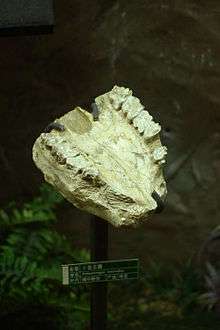Palaeotragus
| Palaeotragus | |
|---|---|
 | |
| A pair of Palaeotragus mounts at the Tianjin Natural History Museum. | |
| Scientific classification | |
| Kingdom: | Animalia |
| Phylum: | Chordata |
| Class: | Mammalia |
| Order: | Artiodactyla |
| Family: | Giraffidae |
| Genus: | †Palaeotragus Gaudry 1861[1] |
| Species | |
|
P. primaevus | |
Palaeotragus ("ancient goat") is a genus of very large, primitive, okapi-like giraffid from the Miocene of Africa, Eurasia.

P. microdon fossil
Palaeotragus primaevus is the older species, being found in early to mid-Miocene strata, while Palaeotragus germaini is found in Late Miocene strata.
P. primaevus is distinguished from P. germaini by the lack of ossicones. It was also the smaller species, being a little under 2 m (6 ft 7 in) at the shoulders. P. germaini had a pair of ossicones, and in life, it would have resembled either a short-necked, 3 m (9.8 ft) tall giraffe, or a gargantuan okapi.
Notes
- ↑ Palaeotragus in the Paleobiology Database. Retrieved May 2013.
References
- Gaudry, Albert (1861). "Paléontologie. — Résultats des fouilles entreprises en Grèce sous les auspices de l'Académie". Comptes-rendus de l'Académie des Sciences. 53. Paris. p. 239. OCLC 469002103.
| Wikimedia Commons has media related to Palaeotragus. |
This article is issued from
Wikipedia.
The text is licensed under Creative Commons - Attribution - Sharealike.
Additional terms may apply for the media files.